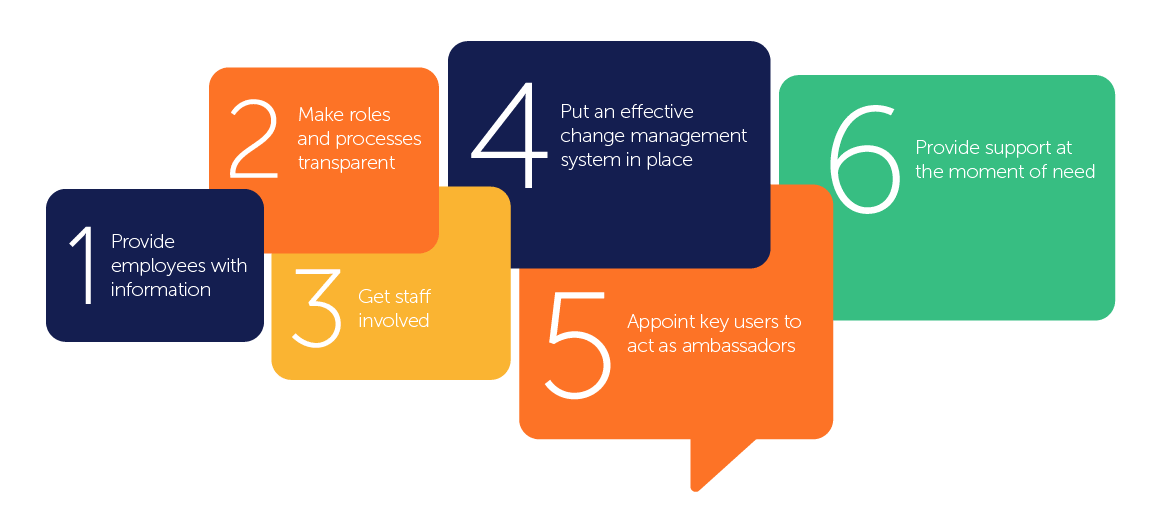The human factor – six things you should consider before implementing SAP S/4HANA

It doesn’t matter how promising a business model is, how cutting-edge a technology is, how clever a piece of software is or how efficient a process is – companies that don’t factor their employees into the equation will ultimately never be successful. After all, they are the ones who have to use the new technology or software as profitably as possible, thus helping to safeguard the company’s success. Software is only as good as the users who work with it.
To ensure this is done with confidence and commitment, it is important for them to understand the added value of the solution, as staff will then be more open to new technologies and software. To describe this willingness to enter unfamiliar digital territory, specialists in the field have coined the terms “digital adoption” and “user adoption”. The higher the level of the latter present among the workforce, the easier it is for a company to introduce new software and processes.
Yet as easy as it may sound in theory, in practice this is a lot harder than you might think. Why? Because you can’t just roll out user adoption the same way as you would a new software solution. Instead, it goes hand in hand with a certain innovative mindset. You can't just instill this kind of attitude in a whole company overnight. It’s a much longer process, and for it to have any chance of success, managers need to follow certain values – linked primarily to how staff interact with each other and a shared will to reach a goal – and employees have to see these as worth imitating and ultimately live by these values, too. This is a big task and a long journey. However, every journey begins with a first step. This step might involve taking account of the following rules when implementing a new piece of software such as SAP S/4HANA, for example.

Six things you should consider before implementing SAP S/4HANA
1. Provide employees with information
Tell the future users about your plans and explain the reasoning behind the decision for SAP S/4HANA and its purpose. What is the company aiming to achieve? What advantages will users have from the roll-out? Don’t wait till the start of the implementation to begin communicating information – make it part of the planning phase. It is especially important to indicate any potential limitations the implementation may cause.
2. Make roles and processes transparent
SAP S/4HANA will cause changes to processes, and therefore to the jobs and roles of staff members. This could include new responsibilities. These changes need to be explained and accompanied by communication, so that users understand the new features and discover their benefits, such as faster workflows, fewer errors and greater efficiency. The earlier this happens, the better the staff acceptance will be.
3. Get staff involved
There are two advantages to getting employees involved at an early stage. First, users can familiarize themselves with SAP S/4HANA before the go-live, which leads to much better acceptance. Second, you can use this test phase to identify and rectify weak points. Both the ERP system and users are then ready to go when the day of the go-live comes.
4. Put an effective change management system in place
Embed the launch of SAP S/4HANA in a comprehensive change management process and use lots of little activities around the time of the kick-off rather than one big event. This should include various communication activities such as Q&A sessions, blog posts and tips that are distributed to staff via push services. At the same time, you should offer appropriate training courses, combined with cutting-edge user support.
5. Appoint key users to act as ambassadors
If you are entering new territory, it’s good to have a compass you can consult. When implementing SAP S/4HANA, key users can take on this role. They are in on the project from the outset, are well trained, and are familiar with the new software. As part of this role, they can act as central contacts for other members of staff (first-level support), and are therefore vital to promoting user adoption.
6. Provide support at the moment of need
The faster users become familiar with the new solution, the smoother the transition will be. Training courses can be valuable in this regard. All the same, questions can still arise when working with the new software – especially in the familiarization period. Users then need fast, direct support. This is where performance support comes in – right at the moment of need. The solution guides users through SAP S/4HANA one step at a time, providing the necessary information should they get stuck at any point in the work process.
These rules should not be seen as strict points for action that must be worked through in order to achieve success. Companies are too different for this, and every company has its own area of focus. However, each of these points does have the potential to promote user adoption and therefore have a positive effect on cultural change within the company.




